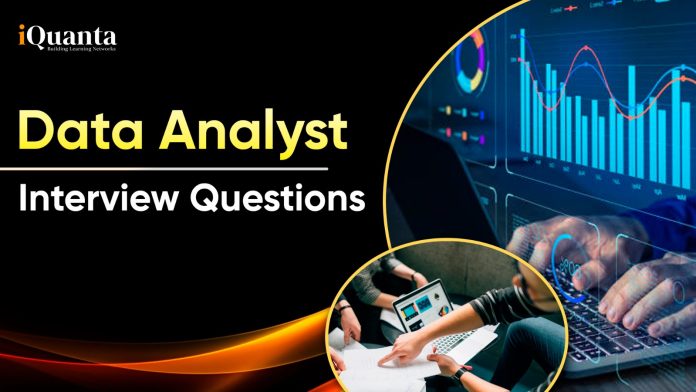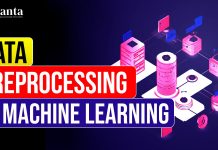In 2025, data is really important and required to dominate decision making across different industries taking you from finance and e-commerce to healthcare. Organizations need to make faster decisions and for that they are demanding highly skilled data analysts to reach new heights.
Whether you are a fresher preparing for your first job or an experienced professional looking to join a top-tier tech company. The competition is crucial among competitors in the market and companies are not just looking for people who can crunch numbers but they want data analysts who can interpret, visualize, and communicate insights that drive business insights.
One of the smartest ways to prepare is by mastering the most frequently asked question in an interview taking from the technical concepts like SQL, Excel, Python to statistical reasoning and data visualization strategies.
Companies are highly focusing on practical problem solving skills, so as to know how to answer with confidence and without any error properly.
In this blog, we will be talking about top 30 data analyst interview questions and answers for 2025, carefully based on hiring trends, a startup, MNC, or FAANG-level role. These questions will help you build a strong foundation and walk into your interview with confidence.
Data Analyst Interview Questions and Answers
Preparing for a data analyst interview means being ready to describe both technical as well as analytical skills. Below are some commonly asked questions across companies in 2025. It is ideal for freshers, experienced as well as professionals.
What is the difference between data analysis and data mining?
Data analysis is the process of collecting, cleaning, interpreting, and visualizing data to uncover insights and support decision-making. Data mining, on the other hand, focuses on discovering hidden patterns in large datasets using machine learning and statistical techniques. While data analysis is broader and includes storytelling and reporting, data mining is more algorithm-driven.
What are the key steps in the data analysis process?
The data analysis process typically includes:
- Defining the problem or objective
- Collecting and cleaning the data
- Exploring data patterns (EDA)
- Analyzing and modeling
- Interpreting and communicating insights
- Creating dashboards or reports
How do you handle missing or corrupted data in a dataset?
Handling missing or corrupted data is a critical part of preprocessing. Depending on the situation, you might:
- Remove rows with missing values (if few)
- Impute values using mean, median, or mode
- Use predictive models or interpolation
- Flag missing data for special treatment
The approach depends on how much data is missing and whether it affects your analysis.
What is data normalization and why is it important?
Data normalization is the process of scaling numeric values to a common range, often between 0 and 1. It ensures that no single feature dominates others due to scale. Normalization is especially important in machine learning models and clustering algorithms, where feature scales impact performance.
What are your go-to tools for data analysis?
There are some popular tools to perform data analysis which includes:
- Excel – for quick calculations and pivot tables
- SQL – for querying structured data
- Python (Pandas, NumPy) – for data cleaning and analysis
- Power BI/Tableau – for data visualization
Choosing the right tool depends on the size of data, use case, and collaboration needs.
Python Data Analyst Interview Questions
Python is one of the most widely used programming languages in data analysis. Interviewers frequently ask Python-based questions to assess your ability to manipulate, analyze, and visualize data efficiently. Here are some of the most relevant Python data analyst interview questions and answers you should prepare for:
What are the most commonly used Python libraries for data analysis?
The most commonly used Python libraries in data analysis are:
- Pandas – for data manipulation and preprocessing
- NumPy – for numerical operations and array handling
- Matplotlib/Seaborn – for data visualization
- Scikit-learn – for basic machine learning and modeling
These libraries are essential in almost every data analysis task and are frequently discussed in python data analyst interview.
How does the groupby() function work in Pandas?
groupby() in Pandas is used to split the data into groups based on one or more columns, apply a function (like mean, sum), and then combine the results.
Example:
df.groupby('department')['sales'].sum()This function is critical for summarizing and aggregating data which is making it a go-to tool during data analysis with Python.
What is the difference between a list and a tuple in Python and why does it matter in data analysis?
- A list is mutable (can be changed) and uses more memory.
- A tuple is immutable (cannot be changed) and is faster for iteration.
In data analysis, tuples are often used for fixed-size data like coordinates or when performance is a priority.
How would you handle missing data using Python?
Python’s Pandas library offers several ways to handle missing values and choosing the right method depends on the business context and data quality. This is a core part of many python data analyst interview questions.
SQL Data Analyst Interview Questions
SQL is an essential skill for any data analyst role. Whether you’re joining a startup or a Fortune 500 company, you’ll likely be asked to write queries, manipulate data, and demonstrate a solid understanding of relational databases. Here are some of the most asked SQL data analyst interview questions for 2025.
What is the difference between WHERE and HAVING clauses in SQL?
The WHERE clause filters rows before grouping, while the HAVING clause filters after grouping.
Example:
- Use WHERE to filter individual rows:
SELECT * FROM sales WHERE region = ‘East’; - Use HAVING to filter aggregated results:
SELECT region, SUM(sales) FROM sales GROUP BY region HAVING SUM(sales) > 5000;
Explain different types of JOINs in SQL
JOINs are used to combine rows from two or more tables based on a related column.
- INNER JOIN: returns only matching records
- LEFT JOIN: returns all records from the left table and matched records from the right
- RIGHT JOIN: opposite of LEFT JOIN
- FULL OUTER JOIN: returns all records when there is a match in either table.
What are window functions, and how are they used?
Window functions perform calculations across a set of table rows related to the current row without collapsing them into groups.
Example:
SELECT employee, department, RANK() OVER (PARTITION BY department ORDER BY salary DESC) FROM employees;
This assigns ranks within each department.
How can you find duplicate records in a table?
SELECT column_name, COUNT(*)
FROM table_name
GROUP BY column_name
HAVING COUNT(*) > 1;
That wraps up the core SQL data analyst interview questions you must be ready for. SQL tests and live coding rounds are common, so practice writing queries from scratch.
Excel Interview Questions for Data Analyst
| Question | Answer |
| What is the difference between WHERE and HAVING clauses in SQL? | The WHERE clause filters rows before aggregation, while HAVING filters grouped results after aggregation. Example: SELECT region, SUM(sales) FROM sales WHERE region = ‘East’ GROUP BY region HAVING SUM(sales) > 5000; |
| Explain different types of JOINs in SQL. | INNER JOIN: Returns only matching rows from both tables LEFT JOIN: Returns all rows from the left table and matching rows from the right RIGHT JOIN: Returns all rows from the right table and matching rows from the left FULL OUTER JOIN: Returns all rows when there’s a match in either table |
| What are window functions, and how are they used? | Window functions perform calculations across related rows without collapsing them. Example: RANK() OVER (PARTITION BY department ORDER BY salary DESC) ranks employees within departments. |
| How can you find duplicate records in a table? | Use GROUP BY and HAVING to count duplicates. SELECT column_name, COUNT(*) FROM table_name GROUP BY column_name HAVING COUNT(*) > 1 |
Data Analyst Interview Questions for Freshers
If you’re just starting your career in data analytics, interviewers won’t expect deep domain expertise — but they will assess your fundamentals, curiosity, and ability to learn quickly. Here are some commonly asked data analyst interview questions for freshers in 2025.
How would you explain data analysis to a non-technical person?
Data analysis is the process of reviewing and interpreting raw data to discover useful insights that support better decision-making. For example, a data analyst might examine customer purchase data to find out which products are selling the most and why. It’s like storytelling with numbers, helping companies understand what’s working and what’s not.
What tools should a beginner data analyst know?
As a fresher, you should be familiar with a few essential tools:
- Excel for basic data cleaning, filtering, and charts
- SQL to query and retrieve data from databases
- Python or R for data manipulation and automation
- Data visualization tools like Tableau or Power BI for presenting insights
Having hands-on experience with at least two of these can give you a solid foundation.
What types of projects can you showcase as a fresher?
You can work on academic or self-initiated projects such as:
- Analyzing COVID-19 trends using public datasets
- Visualizing sales data for an e-commerce business
- Building a dashboard to track personal finance
These show your ability to apply data analysis concepts, even without corporate experience.
How do you stay updated with the latest trends in data analytics?
You can stay updated by following online platforms like:
- Medium (Towards Data Science)
- Kaggle (for competitions and datasets)
- LinkedIn (follow thought leaders and companies)
- YouTube channels or blogs that teach practical skills
Demonstrating that you proactively learn and grow gives interviewers confidence in your long-term potential.
Data Analyst Technical Interview Questions
During technical interviews, hiring managers want to see how well you understand data, solve problems, and communicate your thought process. Below are common data analyst technical interview questions asked in 2025.
What kind of technical assessments do companies give during interviews?
Most companies begin with a hands-on task. You might write SQL queries, clean messy datasets in Excel, or use Python to explore data. Some roles include a case study or take-home assignment where you’re expected to analyze a dataset and present clear insights.
How do you approach a dataset during a live technical round?
Start by clarifying the problem statement. Next, clean the data by removing missing values, correcting formats, and fixing duplicates. Then, explore the data using basic statistics and visualizations. Finally, share your findings in a simple and actionable format. This structured process helps you stay focused and efficient.
What is the difference between supervised and unsupervised learning?
Supervised learning uses labeled data to predict specific outcomes like predicting next month’s sales. In contrast, unsupervised learning finds hidden patterns, such as customer segments, without using labeled data. While analysts don’t always build models, understanding these concepts helps when working with data science teams.
How do you ensure your analysis is accurate?
Check your data for errors early. Run sanity checks like counting rows or scanning for duplicates. Use different methods to verify your results. It’s also helpful to review your work or have someone else double-check it. This reduces mistakes and builds trust in your analysis.
Bonus Tips for Cracking the Interview
Preparing answers to common questions is just one part of the process. To truly stand out in your data analyst interview, you need to go beyond the basics and show you can apply your knowledge in real scenarios. Here are some effective tips that can boost your chances of getting hired in 2025.
Build a strong project portfolio
Interviewers love to see practical experience. Include 2–3 well-documented projects on GitHub or your resume. These could be case studies like sales data analysis, customer segmentation, or COVID-19 trend analysis using Python, Excel, or Power BI.
Master the tools, not just the theory
Practice using SQL, Python (especially Pandas and NumPy), and Excel regularly. Create dashboards with Tableau or Power BI to develop your visualization skills. Don’t just memorize functions—know when and why to use them.
Practice mock interviews
Take free or paid mock interviews to simulate real pressure. Sites like Pramp or Interviewing.io offer data analyst mock sessions where you can get feedback and improve your confidence.
Improve communication and storytelling
You’ll often need to explain your analysis to non-technical stakeholders. Practice breaking down your findings into clear, actionable insights. Use visuals to make your message even stronger.
Stay updated with data trends
Follow blogs, newsletters, and thought leaders on platforms like Medium, LinkedIn, and YouTube. This shows curiosity and adaptability—qualities every employer looks for.
Bonus tip
Be curious and ask questions during the interview. Whether it’s about the data infrastructure, the team’s goals, or the company’s challenges, genuine curiosity can help you stand out as someone who cares about the business and not just the role.
Conclusion
Landing a data analyst role in 2025 is all about preparation, practical skills, and clear communication. Whether you’re a fresher trying to break into analytics or an experienced candidate aiming for a more advanced position, understanding the most relevant data analyst interview questions can make all the difference.
In this guide, we have covered everything from general and technical questions to Python, SQL, and Excel-based scenarios along with bonus tips to help you stand out in interviews. Keep in mind, interviewers aren’t just looking for the right answers. They are also evaluating how you think, solve problems, and translate data into decisions.
As you prepare, focus on building a portfolio, practicing case studies, refining your storytelling, and staying updated with tools and trends. With consistency and smart preparation, you’ll be well on your way to becoming a standout candidate.


![Top 10 Applications of Linked List Data Structure [2025]](https://www.iquanta.in/blog/wp-content/uploads/2025/02/WhatsApp-Image-2025-02-01-at-2.48.42-PM-218x150.jpeg)

